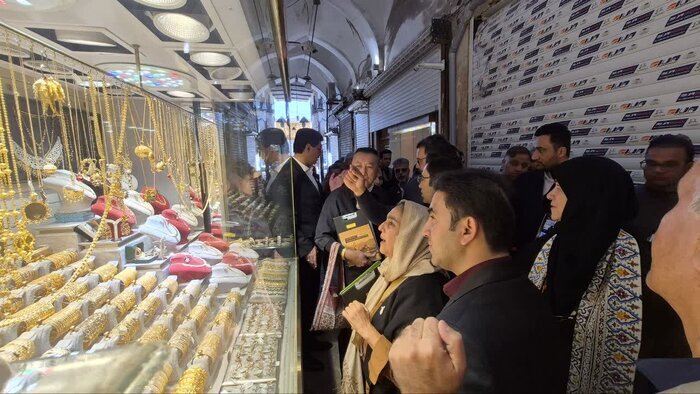Yazd eyes global recognition for traditional jewelry

TEHRAN - The ancient city of Yazd, already a UNESCO World Heritage site, is now being considered for designation as a World City of Traditional and Handcrafted Jewelry by the World Crafts Council (WCC).
On Saturday, A team of WCC experts arrived in Yazd to assess its potential for this prestigious title and engage with local artisans and officials.
A high-profile meeting was held at the Kowsar Hall of the Yazd Governor-General’s Headquarters, attended by Iran’s Deputy Minister of Handicrafts and Traditional Arts, Maryam Jalali-Dehkordi, Yazd province’s Governor-General Mohammadreza Babaei, and other officials and artisans.

Addressing the meeting, Jalali-Dehkordi emphasized the importance of linking traditional identity-based economies with digital markets, stating that integrating traditional crafts with modern technologies such as blockchain and artificial intelligence could significantly enhance their global reach.

She praised Yazd’s deep-rooted artistic heritage, highlighting the role of its skilled artisans in preserving and passing down their craft through generations.
Jalali-Dehkordi also pointed out that the city’s unique combination of cultural preservation and modernization has made it a prime candidate for international recognition. She stressed the necessity of collaboration between the public and private sectors, as well as the unity among Yazd’s craftspeople, to successfully expand into global markets.
Babaei, for his part, underscored the significance of the evaluation process, calling it a turning point for Yazd’s traditional jewelry industry. He noted that the city’s multicultural history, including its religious diversity, has contributed to its rich artistic traditions.

He expressed optimism that obtaining the WCC label would not only elevate Yazd’s cultural status but also drive economic growth and innovation in the handicrafts sector.
If approved, the designation as a world city of traditional and handcrafted jewelry will mark another milestone in Yazd’s long and distinguished history as a center of craftsmanship and cultural heritage.
Yazdi Zargari
The history of Zargari, or the art of jewelry making, in the historic city of Yazd dates back approximately 2,000 years, as supported by reliable evidence. This ancient craft has been passed down through generations, maintaining its distinctive and intricate techniques that make Yazdi jewelry nearly impossible to replicate. Some exquisite pieces, dating back 500 years, are found exclusively in Yazd.
Jewelry making is one of the most renowned traditional arts of Yazd, recognized both in Iran and internationally as Yazdi Zargari.
Unlike the standard 18-karat gold commonly produced in Iran, Yazd’s traditional goldsmiths craft their pieces with a fineness of 20 karats. This higher purity level is one of the key factors behind the esteemed reputation of Yazd’s traditional jewelry.
Available evidence shows the discovery of jewelry from the Parthian era, dating back around 2,000 years, in the historic region of Mehriz. These findings further attest to the city's deep-rooted legacy in gold ornamentation.
One of the most iconic jewelry pieces from Yazd is the "Chin-Abi" chain, named after its unique manufacturing technique. The hallmark of this chain is its extraordinary softness, designed to mimic the fluidity of water. It is crafted from delicate golden filaments, rods, and 20-karat gold rings unique to Yazd, often combined with copper and silver alloys.

Other traditional chain-making methods, such as "Hel Malileh Yazdi," "Toop Malileh Yazdi," and "Hel va Gol-e Yazd," are distinctive techniques belonging to Yazdi Zargari.
Those time-honored craftsmanship techniques have been officially recognized and registered as part of Iran’s intangible cultural heritage, ensuring their preservation for future generations.
A must-see destination
In July 2017, the historical core of Yazd, the provincial capital, was named a UNESCO World Heritage site. Yazd is regularly referred to as a delightful place to stay, or a “don’t miss” destination by almost all of its visitors. The city is full of mudbrick houses that are equipped with innovative badgirs (wind catchers), atmospheric alleyways, and many Islamic and Iranian monuments that shape its eye-catching city landscape.
Cultural heritage experts believe that Yazd is a living testimony to the intelligent use of limited available resources in the desert for survival. Water is brought to the city by the qanat system. Each district of the city is built on a qanat and has a communal center. Furthermore, the use of earth in buildings includes walls and roofs through the construction of vaults and domes. Houses are built with courtyards below ground level, serving underground areas. Wind-catchers, courtyards, and thick earthen walls create a pleasant microclimate.
The historical core of Yazd is chockfull of mudbrick houses, bazaars, public bathhouses, water cisterns, mosques, synagogues, Zoroastrian temples, and centuries-old gardens. From the divine point of view, the city enjoys the peaceful coexistence of three religions: Islam, Judaism, and Zoroastrianism.
Yazd is home to numerous qanats which have supplied water to agricultural and permanent settlements for thousands of years. The man-carved underground qanat system relies on snow-fed streams flowing down the foothills of surrounding mountains. The earliest water supply to Yazd is estimated to date from the Sassanid era (224 to 651 CE). However, many others have been continually repaired and used over time, and most surviving Ab-Anbars (traditional mudbrick cisterns) can today be traced to the late Safavid and Qajar periods.
AM
